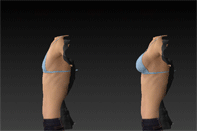Throughout the centuries civilizations have had different ideas regarding what constitutes the perfect female body shape. For example, in today’s society large breasts, straight hair down to your shoulders, a big butt and full lips are considered the ideal standards of female beauty.
But if we were to put that same woman in a time machine and send her to the 1920’s, she wouldn’t be considered very attractive. In the 20’s men tended to favor women with a boyish type of body, flat breasts and a short curly hairdo.
It’s interesting to see what people considered to be the ideal standards for the female body type and shape since the dawn of civilized society. Here is a brief history on what was considered beautiful throughout the years.
Some of the beauty standards might lead you to believe that things haven’t changed that much throughout the millennia.
Ancient Egypt – Women who were slender were considered the ideal standard of beauty amongst the ancient Egyptians. Their society placed a heavy value on a high waist and symmetrical face as well. Not unlike today’s society, the Egyptian people have been described as being “extremely vain”. Body hair was considered to be a sign of impurity and uncleanliness amongst women.
Rome – The Romans took their standards of beauty to an all new level never seen before in history. If plastic surgery were a thing in Roman times, the surgeons would probably be wealthier than the emperor himself.
For the average Roman woman to be considered beautiful, she had to have:
- Small, sharp nose
- Pretty feet
- Pale white skin (only the slaves worked under the hot sun in the fields)
- Wide thighs
- Small breasts
- Lack of body hair
- Large almond-shaped eyes, oval cheeks and chins.
The ideal of beauty for women was small, thin but robust constitution, narrow shoulders, pronounced hips, wide thighs and small breasts. Considering that there was no such thing as rhinoplasty in Roman times, women had to work with what they were given.
Greece – In ancient Greece, women were considered disfigured versions of men. Society placed a higher value on the male physique than the female physique. Women who were plump and full bodied were deemed the most attractive in this historical timeperiod. As with the Egyptians and Romans, fair pale skin was most desirable amongst fashionable women.
Italian Renaissance – This was the golden age for women who were “plump and voluptuous”. The Italian standard of female beauty placed a heavy focus on women who by today’s standards would be considered “overweight”.
It’s interesting to note that Roman women did not use a lot of cosmetics. They placed a heavy value on women whose bodies were completely natural -as given to her by God. The Italian Renaissance would probably be one of the last places a time-travelling plastic surgeon would want to set up shop and offer liposuction services.
Victorian England – As with the Italian Renaissance, Victorian English society placed high value on women who were “desirably plump” and full-figured. However, it wasn’t an all-you-can-eat buffet in terms of beauty standards. A cinched waist was considered to be very sexy and in order for most women to achieve this look, they had to wear an uncomfortable corset most of the time.
Pale white skin was also in fashion and to achieve this look women used a variety of cosmetic products that contained such toxins as lead and arsenic.
Roaring 20’s – Flash forward 90 or so years and the 1920’s version of female beauty is the exact opposite of what it was in Victorian England times. As with the Flappers, women who were flat-chested with a downplayed waist, boyish figure and short bob hairstyle were considered the ideal standard of beauty.
Golden age of Hollywood (30’s-50’s) – Marilyn Monroe gave rise to the popular curvy, hourglass figure of the 1930’s-1950’s. Women wanted large, pointy breasts and used a wide variety of bra contraptions to achieve this look. As with Victorian women, a slim waist was also valued.
1960’s – The ideal standard for attractiveness in women was slenderness. A British model by the name of Twiggy became very popular in America and many women tried to emulate her look. She had a skinny frame and boyish look to her. At this time Americans were gaining weight faster than ever and Twiggy gave birth to the “skinny is better” mantra that most fashion magazines still promote today.
1990’s –The 90’s were unique in that they had two main beauty ideals. Women like Naomi Campbell and Cindy Crawford gave rise to the athetic-but-curvaceous body figures. On the other hand, such models as Kate Moss gave rise to the popularity of “heroin chic” in which it was fashionable to look as skinny as a drug addict. It’s interesting to note that having a big butt or a large thigh gap was considered to be overweight.
2000’s – Present day – Nowadays women are looking to have large breasts and butts. This is due in part to the rise in popularity of various “reality t.v. shows” where the stars have big breasts and posteriors. Women nowadays also want to look “healthy skinny”, not the “heroin chic” that was so popular in the 1990’s.
A thigh gap is also seen as attractive. More so than any other time in history, women nowadays regularly get plastic surgery to achieve the look they desire. When supplemented with regular exercise and a healthy diet, it’s relatively easy to obtain a healthy and athletic look.
Over the history of mankind, the standards for beauty have changed considerably. Considering plastic surgery did not exist until recently, women were stuck with what they were born with. They couldn’t change the size of their breasts or shape of their nose as medical science was in its infancy.
Nowadays, women are fortunate in that plastic surgery is a safe, routine and reliable way of changing and improving their body and looks. At Dr. Adams plastic surgery, we have helped countless women get the look that they desire. Give us a call to schedule an appointment.















